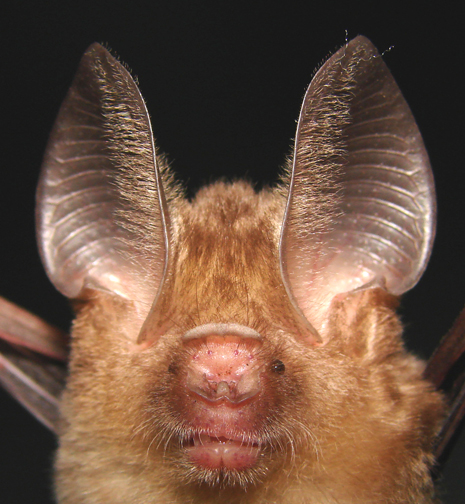Listening for Love: A role for echolocation in mate choice?

© S.J. Puechmaille. The bat species Hipposideros pomona is one of the many bat species echolocating at high frequency (140 kHz), well above the human hearing range (20 kHz).
They showed for the first time that bats are indeed ‘listening’ for a good mate rather than ‘looking for one’. Combining ecology, genetics and behavioural experiments of wild bats, this study showed that female Rhinolophus mehelyi horseshoe bats are using echolocation to choose a mate.
Probably the most important decision in any animal’s life, including our own, is finding the best mate! If you make the wrong decision then this can have repercussions for generations. Your choice of mate enables the transfer and continuation of your genes and indeed can drive the evolution of a species.
For humans, typically the first things that attracts you to a potential mate are visual cues, how well or attractive a person looks. ‘Good-looks’ have shown to be correlated with ‘good-genes’ or better fitness, so this makes sense. Well imagine having to find a mate in total darkness? This is the ultimate challenge that bats face.
Of all mammal species, bats are the hearing specialists. They use echolocation or sonar, to orient and detect prey in complete darkness, relying on the echo of their ultrasound calls to develop an acoustic image of their environment. Bat echolocation is considered to be one of the most fascinating yet least well understood modes of sensory perception.
Unlike bird song, the primary role of echolocation in bats is for orientation and finding food in complete darkness. Little is known about its use in communication and mate choice. Indeed, only in the past decade has it been suggested that echolocation calls can actually encode information on sex, body size, age and its role in mate choice has never been tested.
To test this hypothesis, the researchers have designed a suite of experiments and analyses on a wild population of Rhinolophus mehelyi near Tabachka research station in Bulgaria. The results of the experiments were pretty clear. The higher the frequency of the male’s call the more attractive the male is to the females. The higher the frequency of the male’s call the more, off-spring he will sire. Indeed, the male’s echolocation call seems to act like a ‘peacock’s tail’, the higher the frequency the more attractive the call.
However, despite this sexual advantage, these higher frequency calls are considered to be less efficient for foraging, and ultimately are an ‘attractive’ handicap. The male might ‘sound’ better to females but he can’t hunt as optimal-ly. It appears that the female’s preference for males with higher echolocation call frequency may explain why this species echolocates at 30 kHz higher than expected, something that has puzzled scientists until now. This evolutionary ‘trade-off’ between efficiency and attractiveness moulds and constrains bat echolocation.
This study is the first to show the role of echolocation in mate choice and will become a reference for future studies. Its power comes from the integration of three different types of data, ecological, behavioural and genetics. These results highlight bats as a novel system in which to explore the role of sound in mate choice and the potential conflict between natural and sexual selection on specific traits in evolution.
This paper has just been published with Open Access in PLOS ONE (http://dx.plos.org/10.1371/journal.pone.0103452) on the 30th July 2014. [Female mate choice can drive the evolution of high frequency echolocation in bats: a case study with Rhinolophus mehelyi DOI: 10.1371/journal.pone.0103452]. It represents an Irish-German driven project, funded by an IRCSET-Marie Curie International Mobility Fellowships in Science, Engineering and Technology awarded to S.J. Puechmaille.
Contact details of authors for correspondence
First author
Dr. Sébastien Puechmaille
Ernst-Moritz-Arndt-University of Greifswald
Zoology Institute
Johann-Sebastian-Bach-Str. 11/12
17489 Greifswald, GERMANY
Phone +49 3834 86-4068
s.puechmaille@gmail.com
Senior author
Prof. Emma Teeling
School of Biology and Environmental Science
University College Dublin, IRELAND
Phone +35 31 7162263
emma.teeling@ucd.ie
Media Contact
All latest news from the category: Life Sciences and Chemistry
Articles and reports from the Life Sciences and chemistry area deal with applied and basic research into modern biology, chemistry and human medicine.
Valuable information can be found on a range of life sciences fields including bacteriology, biochemistry, bionics, bioinformatics, biophysics, biotechnology, genetics, geobotany, human biology, marine biology, microbiology, molecular biology, cellular biology, zoology, bioinorganic chemistry, microchemistry and environmental chemistry.
Newest articles

High-energy-density aqueous battery based on halogen multi-electron transfer
Traditional non-aqueous lithium-ion batteries have a high energy density, but their safety is compromised due to the flammable organic electrolytes they utilize. Aqueous batteries use water as the solvent for…

First-ever combined heart pump and pig kidney transplant
…gives new hope to patient with terminal illness. Surgeons at NYU Langone Health performed the first-ever combined mechanical heart pump and gene-edited pig kidney transplant surgery in a 54-year-old woman…

Biophysics: Testing how well biomarkers work
LMU researchers have developed a method to determine how reliably target proteins can be labeled using super-resolution fluorescence microscopy. Modern microscopy techniques make it possible to examine the inner workings…





















